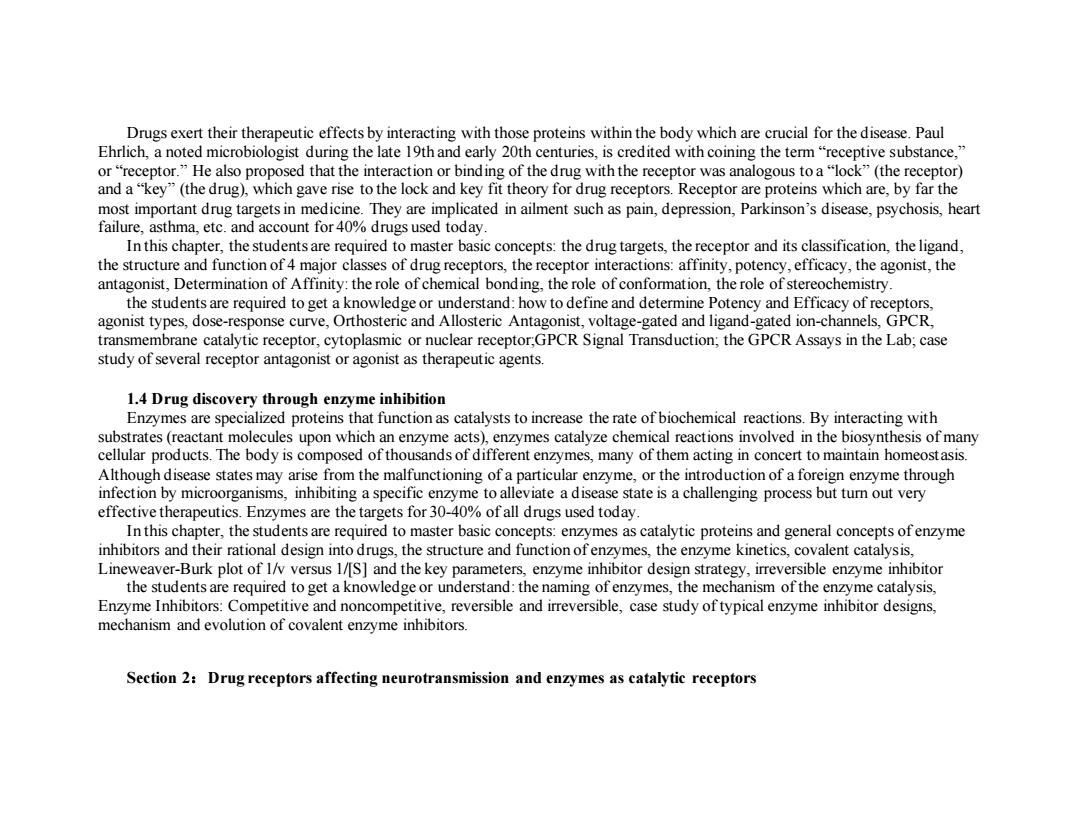正在加载图片...

Drugs exert their therapeutic effects by interacting with those proteins within the body which are crucial for the disease.Paul Ehrlich,a noted microbiologist during the late 19th and early 20th centuries,is credited with coining the term "receptive substance," or"receptor."He also proposed that the interaction or binding of the drug with the receptor was analogous to a"lock"(the receptor) and a"key"(the drug),which gave rise to the lock and key fit theory for drug receptors.Receptor are proteins which are,by far the most important drug targets in medicine.They are implicated in ailment such as pain,depression,Parkinson's disease,psychosis,heart failure,asthma,etc.and account for 40%drugs used today. In this chapter,the students are required to master basic concepts:the drug targets,the receptor and its classification,the ligand, the structure and function of 4 major classes of drug receptors,the receptor interactions:affinity,potency,efficacy,the agonist,the antagonist,Determination of Affinity:the role of chemical bonding,the role of conformation,the role of stereochemistry. the students are required to get a knowledge or understand:how to define and determine Potency and Efficacy of receptors, agonist types,dose-response curve,Orthosteric and Allosteric Antagonist,voltage-gated and ligand-gated ion-channels,GPCR, transmembrane catalytic receptor,cytoplasmic or nuclear receptor;GPCR Signal Transduction;the GPCR Assays in the Lab;case study of several receptor antagonist or agonist as therapeutic agents. 1.4 Drug discovery through enzyme inhibition Enzymes are specialized proteins that function as catalysts to increase the rate of biochemical reactions.By interacting with substrates (reactant molecules upon which an enzyme acts),enzymes catalyze chemical reactions involved in the biosynthesis of many cellular products.The body is composed of thousands of different enzymes,many of them acting in concert to maintain homeostasis. Although disease states may arise from the malfunctioning of a particular enzyme,or the introduction of a foreign enzyme through infection by microorganisms,inhibiting a specific enzyme to alleviate a disease state is a challenging process but turn out very effective therapeutics.Enzymes are the targets for 30-40%of all drugs used today. In this chapter,the students are required to master basic concepts:enzymes as catalytic proteins and general concepts of enzyme inhibitors and their rational design into drugs,the structure and function of enzymes,the enzyme kinetics,covalent catalysis, Lineweaver-Burk plot of 1/v versus 1/[S]and the key parameters,enzyme inhibitor design strategy,irreversible enzyme inhibitor the students are required to get a knowledge or understand:the naming of enzymes,the mechanism of the enzyme catalysis, Enzyme Inhibitors:Competitive and noncompetitive,reversible and irreversible,case study of typical enzyme inhibitor designs, mechanism and evolution of covalent enzyme inhibitors. Section 2:Drug receptors affecting neurotransmission and enzymes as catalytic receptorsDrugs exert their therapeutic effects by interacting with those proteins within the body which are crucial for the disease. Paul Ehrlich, a noted microbiologist during the late 19th and early 20th centuries, is credited with coining the term “receptive substance,” or “receptor.” He also proposed that the interaction or binding of the drug with the receptor was analogous to a “lock” (the receptor) and a “key” (the drug), which gave rise to the lock and key fit theory for drug receptors. Receptor are proteins which are, by far the most important drug targets in medicine. They are implicated in ailment such as pain, depression, Parkinson’s disease, psychosis, heart failure, asthma, etc. and account for 40% drugs used today. In this chapter, the students are required to master basic concepts: the drug targets, the receptor and its classification, the ligand, the structure and function of 4 major classes of drug receptors, the receptor interactions: affinity, potency, efficacy, the agonist, the antagonist, Determination of Affinity: the role of chemical bonding, the role of conformation, the role of stereochemistry. the students are required to get a knowledge or understand: how to define and determine Potency and Efficacy of receptors, agonist types, dose-response curve, Orthosteric and Allosteric Antagonist, voltage-gated and ligand-gated ion-channels, GPCR, transmembrane catalytic receptor, cytoplasmic or nuclear receptor;GPCR Signal Transduction; the GPCR Assays in the Lab; case study of several receptor antagonist or agonist as therapeutic agents. 1.4 Drug discovery through enzyme inhibition Enzymes are specialized proteins that function as catalysts to increase the rate of biochemical reactions. By interacting with substrates (reactant molecules upon which an enzyme acts), enzymes catalyze chemical reactions involved in the biosynthesis of many cellular products. The body is composed of thousands of different enzymes, many of them acting in concert to maintain homeostasis. Although disease states may arise from the malfunctioning of a particular enzyme, or the introduction of a foreign enzyme through infection by microorganisms, inhibiting a specific enzyme to alleviate a disease state is a challenging process but turn out very effective therapeutics. Enzymes are the targets for 30-40% of all drugs used today. In this chapter, the students are required to master basic concepts: enzymes as catalytic proteins and general concepts of enzyme inhibitors and their rational design into drugs, the structure and function of enzymes, the enzyme kinetics, covalent catalysis, Lineweaver-Burk plot of 1/v versus 1/[S] and the key parameters, enzyme inhibitor design strategy, irreversible enzyme inhibitor the students are required to get a knowledge or understand: the naming of enzymes, the mechanism of the enzyme catalysis, Enzyme Inhibitors: Competitive and noncompetitive, reversible and irreversible, case study of typical enzyme inhibitor designs, mechanism and evolution of covalent enzyme inhibitors. Section 2:Drug receptors affecting neurotransmission and enzymes as catalytic receptors